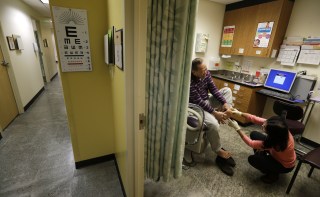What makes U.S. health care so overpriced? It’s not what you think
21 hours ago
 |
| Ted S. Warren / AP |
Chan Lai Ly has his feet examined as part of a regular check-up related
to his diabetes, by Honghue Duong, a physician's assistant. Patients
with chronic diseases account for a huge hunk of health spending, a new
study shows.
And even though the U.S. spends $2.7 trillion a year, nearly 18 percent of gross domestic product (GDP), on health care, it’s not keeping up with the rest of the developed world when it comes to improving people’s health.
“It does show pretty clearly that price is the culprit here,” Dr. Hamilton Moses of the Alerion Institute in Virginia and Johns Hopkins University told reporters.
“Based on this review…the U.S. ‘system’ has performed relatively poorly,” Moses and colleagues wrote in the report, published in the Journal of the American Medical Association. Their findings echo what other experts have found – U.S. health care gives little value for the money.
One big problem is that people have no idea what they are paying for health care services, so traditional free market forces cannot act to keep costs down. “This is not a market. It’s far from a market. Few prices are known. They are not publicized,” Moses says.
The perception is that a bigger proportion of the population is getting old and sick, and using more and more services. But Moses and colleagues say their review didn’t show that.
“In 2011, chronic illnesses account for 84 percent of costs overall among the entire population, not only of the elderly. Chronic illness among individuals younger than 65 years accounts for 67 percent of spending,” they found.
“Price of professional services, drugs and devices, and administrative costs, not demand for services or aging of the population, produced 91 percent of cost increases since 2000.”
And while some opponents of health care reform have been saying the U.S. health care system is the best in the world, the statistics don’t support that.
U.S. life expectancy is getting longer, but it’s lagging behind the longer lifespans enjoyed by people in most of western Europe and Japan. And there are huge disparities across the country, with people in states like Mississippi considerably less healthy than people in Colorado or New York City.
Moses points to a very big culprit – the standard fee-for-service system that encourages doctors and other caregivers to give lots of tests, individual treatments and to prescribe drugs, instead of keeping patients well. It’s not a new idea, but Moses says his team’s study shows it very clearly.
“This is a very myopic country,” he said. “There are lessons to be learned from other countries. Chronic illness is where the misery is, it is where the money is and it is where the greatest opportunity lies.”
Moses and his team deliberately did not look at some of the changes outlined in the 2010 Affordable Care Act, widely known as Obamacare. Moses said some of the issues have become too politicized. But the law does try to encourage hospitals and caregivers to move away from a system that pays for individual procedures to one that rewards for keeping patients well.
More could and should be done, Moses says, to encourage better care of people with heart disease, diabetes and cancer.
“It’s the partisanship that’s perhaps standing in the way,” he said.
Dr. Ezekiel Emanuel, a former Obama administration health adviser who now heads a health policy center at the University of Pennsylvania, agrees that focusing on patients with chronic illnesses is the way to save money. “Preventing them from getting sicker is going to be the most important thing we can do to save costs,” he told the news conference.
That might include a system that encourages home visits, since hospital visits are so expensive, he added. “(Patients) like it better and it’s cheaper," Emanuel said.

No comments:
Post a Comment